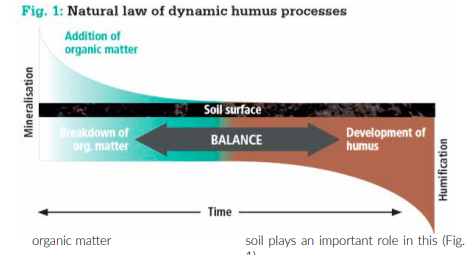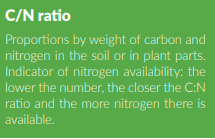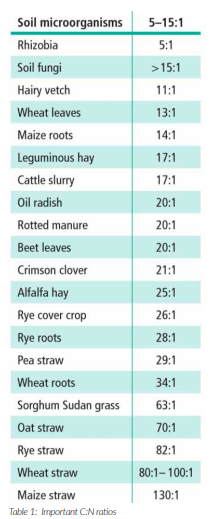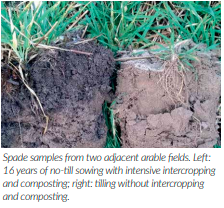Written by Christoph Felgentreu, Jan Hendrik Schulz · Bückwitz from DSV
Farmers have a choice as to which ecological compensation measures they use to meet their greening obligations.
According to the German Federal Ministry of Food and Agriculture (BMEL), around 1.37 million hectares of land were
designated as ecological focus areas in 2015, of which as much as 930,000 hectares were undersown or sown with cover crops. In weighted terms (factor 0.3) this amounts to around 40 % of all greening measures undertaken.
Such widespread use of cover crops or undersowing is unsurprising given the fact that soil fertility, biodiversity and crop rotation have long since become a key part of modern, innovative farming practices on many farms. In this context, we often refer to the humus balance and humification. Cover crops and undersowing are ascribed a humus equivalent of up to 450 kg C/ha/year. In arithmetic terms, therefore, this allows so-called “humus consumers” to be compensated for and enables farmers to meet the requirements of cross compliant farming. This is the arithmetic side, however, and should only be of interest to the farmer from this point of view; after all, it is the biological aspect that is more important for the farmer. Humus is an important store of water and nutrients – especially in arid regions – which also improves the physical and biological properties of the soil. Whether and how much of the added organic matter actually becomes nutrient humus or stable humus depends on many different factors.
The most important factors
• Location (region/soil conditions/soil type)
• Climate/weather conditions
• pH value
• Method and frequency of soil cultivation (oxygenation)
• Use of nitrogen fertilisers, depending on the form of nitrogen (mineral) and type of application (mineral and organic)
• The soil’s current biological status
• Nutritional balance in the soil
• Quantity and quality of added organic matter
• C:N ratio of organic matter
• Crop rotation

These 10 factors alone clearly demonstrate that deskwork is not the only way to establish humification. To illustrate this, let us take a closer look at some of these influencing factors. In the past, too little attention has been paid to the significance of the C:N ratio in the soil and in the organic raw materials needed for humification. The C:N ratio in arable land is generally around 10:1. Assuming a dry bulk density of 1.5 g/ cm3 and 30 cm topsoil, that amounts to 4,500 t soil/ha. Assuming the soil contains 3 % organic matter (humus), that comes to 135,000 kg/ha. The conversion factor (mean) for carbon (Corg) is 0.58, so the arithmetical carbon content is 78,300 kg/ha. At a C:N ratio of 10:1, there is therefore 7,830 kg N stored in the soil. This in turn means that approximately 2,600 kg N/ha would be needed to increase the humus content in our model soil by just 1%. This example shows not only that increasing the humus content depends on a large number of long-term dynamic factors, but also that the nitrogen cycle in the soil plays an important role in this (Fig. 1)

There are two questions to be answered:
1. What are the most favourable conditions for humification?
2. Where do I get the additional nitrogen from?
To answer both these questions, we need to look at the C:N ratio of added organic matter. The organisms primarily responsible for humification processes are fungi and bacteria. Bacteria prefer a lower C:N ratio (< 15:1) while fungi prefer a higher ratio (> 15:1). However, the ideal C:N ratio for humus-forming processes is 24:1, which very much favours fungi (source: USDA, 2013). Bacteria often use nitrogen compounds as a source of energy and oxygen.

Fungi, on the other hand, are generally dependent on plant matter for energy. Many fungi use the lipids (waxes) that form as dead material decomposes as a source of energy. These can usually only be digested by fungi (with the exception of organisms such as actinomycetes), and this process is one of the key aspects in the formation of humic acids and humic substances and therefore in humification. Actinomycetes are a type of bacteria that play an important role in the conversion of organic matter to humic substances. For a long time they were classed as fungi since, like fungi, they are not only filamentous in habit but also behave similarly in many ways. Some break down harmful substances, provide pathogen resistance and the typical fresh smell of the soil, are highly efficient at decomposing cellulose and lignin, and prefer a high C:N ratio. If food is in short supply, actinomycetes can also break down humus, so it is important to ensure a constant supply of nutrients. This partial dependency of actinomycetes on cellulose and lignin raises the issue of straw compensation fertilisation with nitrogen or mineral or nitrogen-containing organic fertilisers (see Table 1).

In certain circumstances, reducing the C:N ratio can encourage bacteria that are detrimental to humus formation and speed up the breakdown of straw – something that was seen as desirable in the past. If the straw is incorporated without nitrogen compensation, it binds nitrogen from the soil pool, which can cause significant problems in the next crop, such as lower yields and a drop in quality. This Gordian knot can be solved by leaving the straw on the surface and sowing the seeds below the straw using suitable drilling techniques (no-till or low-depth reduced tillage).

Another advantage is that this reduces the likelihood of excessive oxygenation. If N fertiliser (mineral or organic) is then applied locally, it will not only be possible to achieve an ideal C:N ratio in the organic matter but also to lessen the influence of the nitrogen on the soil biology. The latter is in turn important when it comes to the additional nitrogen that is essential for humification (promoting nitrogen-fixing bacteria such as Azotobacter). Legumes are undisputedly the most important source of nitrogen. Depending on the species and their use, they can form up to 500 kg N/ha/year. Crucially, it is important to ensure that any excess nitrogen that is developed by leguminous crops is used to promote the formation of humus.
In almost all crops, undersowing with grass is an ideal way of fixing stray nitrogen on the one hand and boosting the C:N ratio on the other. In traditional intercropping, this is achieved by combining legumes with non-legumes. Table 2 very clearly shows the importance of intercropping and crop rotation for the development of soil microbiology. A further promising source of nitrogen for the future is another group of bacteria called Azoarcus. The results of initial trials in maize at our Bückwitz site show that on average over four trial years, around 60 kg N could be attributed to the Azoarcus bacteria with which the maize was inoculated compared to the control with no N.
Conclusion
The conversion of organic matter to humus is a very complex process. The challenge lies in balancing mineralisation, humification and yield. Providing the added organic matter has the optimum C:N ratio for the accumulating microbiological processes of around 24/1 and natural sources of nitrogen can be exploited while reducing tillage and applying nitrogen fertilisation locally, it should be possible for humus to build up if good practice is followed.
